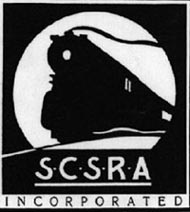
|
DEPARTMENTS
Intro to the SCSRA
|
The Whyte Wheel Classification System for Steam Locomotives
F.M. Whyte, a mechanical engineer, suggested a method of classifying steam locomotives by the number of wheels they had. This system came into use early in the 20th century and is still in common use today.
4-4-0 example
The first place inndicates the number of small wheels which lead the locomotive, known as leading or pilot wheels. These wheels support the weight of the cylinders and smoke box at the front of the locomotive, and give the locomotive stability as it travels.
The second place shows the number of wheels which actually drive the locomotive, and so are called driving wheels. These wheels are larger than either the leading or trailing wheels, and besides propelling the engine, are strategically situated to support the locomotives main weight.
The third place usually gives the number of small wheels which trail the driving wheels, and are named trailing wheels. They can support the weight of the boilers firebox in the cab.
2-4-4-0 example
Sometimes a locomotive's classification number will have four number places - in this case, the third place gives the number of wheels in the second set of driving wheels, and the fourth place shows the number of trailing wheels.
Most locomotive types are also known by a name. For example, the 4-4-0 type is commonly called an "American". Other 19th century classes of locomotives include the 4-6-0 "Ten-wheeler", the 2-6-0 "Mogul", and the 2-8-0 "Consolidation".
One can appreciate the work a particular type of steam locomotive was designed to do by looking at it's wheels, (Don't worry, they're not bashful!) both their arrangement and size. Before the 1880's most locomotives were of the "American" type, and were used for both passenger and freight service, but as the 20th century approached, design became specialized according to use.
For example, freight trains were heavy and long, and demanded great power to get rolling. A heavy locomotive with several pairs of driving wheels satisfied this need - for example, the Western Pacific #26 at Travel Town, which is a "Consolidation" type. On the other hand, passengers expected to arrive at their destinations as soon as possible, so passenger trains required locomotives that could attain high speeds. Since passenger trains were not as heavy as freight trains, passenger train locomotives could sacrifice starting power for speed. An example is the Southern Pacific #3025 at Travel Town, called an "Atlantic" type, sporting only four driving wheels of tremendous 81-inch diameter.
Locomotives used in railroad yards or shops to push around other locomotives and cars usually had small driving wheels and no leading or trailing wheels. Locomotives used within industrial plants were often designed to carry extra water in a saddle-shaped tank right over the boiler, rather than pull a tender around behind them.
Taken from the Travel Town Souvenier Album.
